|
Subscribe / Renew |
|
|
Contact Us |
|
| ► Subscribe to our Free Weekly Newsletter | |
| home | Welcome, sign in or click here to subscribe. | login |
Construction
| |
June 5, 2002
Design team got a workout at Hec Ed
Special to the Journal
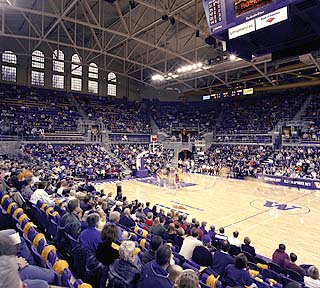
Photo by Jay Dotson For UW's Hec Ed Pavilion, LMN kept the high-arching windows at top left and created a four-sided configuration that focuses on the basketball court.
|
A decade ago, the University of Washington faced pressures familiar to top intercollegiate athletic departments around the country.
Prevailing wisdom said in order to thrive in the contemporary sports world, it would be necessary to double or triple seating capacity as well as update facilities to professional standards. Although they were prepared to act, the university and Husky fans were too attached to Hec Edmundson Pavilion and the history it represented to start all over again.
Designed by Bebb & Gould, the Seattle architecture firm responsible for Suzzallo Library, the University of Washington’s Athletic Pavilion opened in 1927 as a multi-purpose field house set apart from the main campus.
|
Bank of America Arena at Hec Edmundson Pavilion |
|
Owner: Architect: Project type: Seating capacity: Completion date: Construction cost: Structural engineer: Electrical engineer: Mechanical engineer: Code consultant: Associates Cost estimator: Lighting design: Acoustical design: General contractor: Jury Comments:
"Hurray for a non-invasive and clearly articulated structural solution
to reusing this wonderful building. And what could be more collegiate
than purple seats!" "This renovation revives a tired old brick arena
filled with columns, and opens it up as a sporting venue for today's
athletic programs at the university. Through a remarkable structural
tour de force, the columns have been eliminated while keeping the roof
structure (go figure!). It all hinges on two huge elliptical trusses,
painted bright yellow ... or is it Husky gold? The spirit of modernization
infuses every corner of the interior, while sensibly keeping the Italianate
exterior brick box it came in." "The amazing thing about this work is
how it updates and significantly improves a much loved historic facility
while making it seem little changed. The trusses are sleek and clever."
"The design team respected the historic shell of this much loved University
of Washington building, while pulling off a structural tour de force.
By inserting two gigantic yellow trusses, a series of view obstructing
columns were eliminated while the existing roof structure was retained.
This resulted in a much more interesting space with a new sense of volume
and natural light."
|
The original interior of the facility, with its high arched windows and exposed trusses, had been covered over and forgotten since the 1950s, and a series of incremental renovations -- which included locker rooms and storage areas in the 1960s and a complete mechanical system in the 1970s -- further eroded views.
When LMN began to analyze options for renovation in 1993, the basketball arena and seating bowl was spread beneath a hanging acoustic ceiling.
The University of Washington is proud of the historic brick building, with its complex plan, high-arching windows and Husky gargoyles. According to LMN partner-in-charge Chris Eseman, the opportunity to restore the exterior and realize some of the character of the interior was attractive to the athletic department back in 1993, when the firm began to help evaluate options for bringing the facility up to date.
But along with dramatically increasing seating capacity, the department had a long list of priorities: first-class support facilities, with an upgraded sports medicine center; a new home for the Huskies Hall of Fame; a fitting base for the Founders Club; and a new Husky store selling team memorabilia.
All of these added features would fit inside the distinguished old building, but the seating just didn’t seem to work, according to Chip Lydum, assistant director for intercollegiate athletics.
The team looked beyond the Huskies’ Pac 10 conference to other institutions which had renovated old buildings. Duke University in Durham, N.C., had settled for a limited number of seats in its own historic arena, and the subsequent success of the team and enthusiasm of the fans had proven it was a good decision.
Satisfied they were on the right track, the design for a renovated Hec Edmundson Pavilion took off. One of the most urgent problems at Hec Edmundson was the mix of flying practice balls, runners and the occasional errant fan. First, track and field sports would be moved to a new indoor practice facility, now sited nearby and designed by Carlson Architects.
At the new arena, the core of the design problem would be the seating bowl. The LMN team turned to the task at hand: fitting as many as comfortably possible into a limited shell of a building. Some of the flexibility demanded of the arena in the past could now be put aside, and the U-shaped bowl, with a fourth side completely retractable into the east wing of the building, could now be replaced with a permanent, four-sided configuration tightly focused on the basketball court.
The challenge, said Eseman, was dealing with the 20 columns that held up the truss system inside the 7,900-seat arena. Ranked along both sides of the stands, they blocked views and frustrated attempts to make the arena into a setting both intimate and accommodating for up to 10,000 fans.
The breakthrough came during a meeting with the structural engineers. Two "supertrusses," according to Ken Dahl of Skilling Ward Magnusson Barkshire, could span the length of the arena, taking the weight of the other trusses that hold up the ceiling and freeing the entire seating area for sweeping views of the court.
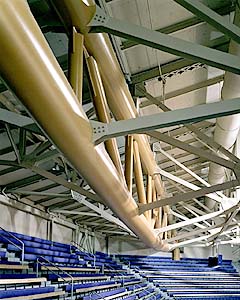
Photo by Tim Hursley Two supertrusses span the length of the arena, and were an innovative solution to replace 20 columns that held up the truss system.
|
The idea was clearly a winner, but a few details had to be worked out. A conventional steel truss designed to replace the existing columns would have to be 20-feet deep -- a view-blocker if there ever was one. The architects said it would not work unless there was a way to make it 11 feet deep.
Dahl and his team went to work. With composite steel and concrete members typically used in skyscraper columns, the engineers fashioned a structural solution. The result is a pair of trim but muscular additions to the Husky scene, a set of supertrusses that add an expressive sculptural element to the newly exposed structure of the arena.
Supporting the original truss system, each supertruss consists of two curving tubular chords that meet at each end of the seating bowl atop giant "supercolumns." The lower chord is filled with pre-stressed concrete to take the compressive load.
The 223-foot-long trusses were assembled on site, then lifted into place under the ceiling structure, held up by jacks. The roof of the arena was essentially lifted and then set back down again on its new supports.
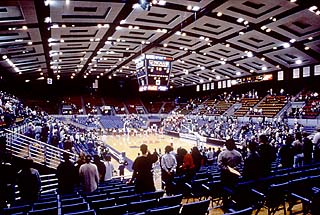
Photo courtesy of LMN Architects Acoustic panels were removed in the renovation of Hec Ed, revealing the historic shell.
|
As they drop beneath the floor of the seating bowl, the columns also get star treatment. Near the main entrances, they are framed by generous openings in the floor plate of the concourse level. At all four corners, supertrusses meet supercolumns in a continuous, color-coded structural performance.
"Sometimes you feel like you could have an art gallery in there," said Lydum. "They turned the structural elements into something."
If the design of the newly named Bank of America Hec Edmundson Pavilion is driven by its new structural elements, the details are governed by making a careful distinction between the old brick shell and the reconfigured interior. Even the wheat board panels that line the outer walls of the concourse are clearly held apart from the brick walls and new seismic reinforcements.
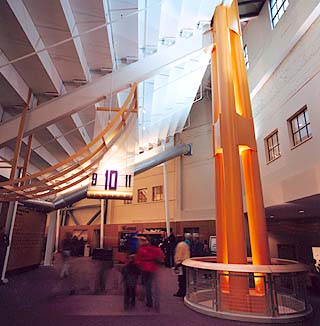
Photo by Jay Dotson Columns holding up the supertrusses are framed by generous openings in the floor.
|
Stairways and landings that anchor the retractable seating of the arena bring modern industrial detailing to the renovation and harden the edges of the floating bowl.
The wide concourses of the original building, intended to accommodate conventions and trade shows, became a spatial windfall that allowed the arena to take on contemporary standards for circulation without radical reconfiguration. The concourse spaces have now become a kind of grand promenade, with exposed supertrusses and architectural details clearly on display.
The newly configured arena is empowered by a subtle change in plan. New entrances have been carved into the northwest and northeast corners of the seating bowl, and they are aligned with outside entrances to the facility.
The result is uninterrupted passage into the center of the action, a pattern with overtones of classical arena architecture.
The view from the concourse into the bright arena is enhanced by curving glass block walls of the restrooms on either side, and a swooping arc of steel reaches out into the concourse, marking each entrance all around the circling concourse.
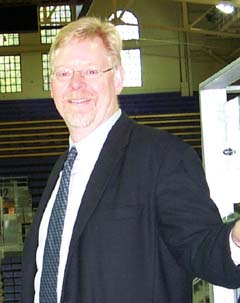
Photo by Clair Enlow LMN partner in charge Chris Eseman said the challenge in Hec Ed was to remove the 20 columns and open up more seating.
|
The new Husky Store marks one entrance to the concourse level. The ground floor is now dedicated to team support areas -- locker rooms, equipment storage and training, as well as meeting spaces. Football and men’s and women’s basketball, volleyball and gymnastics are all based there. A new sports medicine clinic, with connections to team areas and to a new entrance to the north, is also located on the ground floor.
A renovated practice gym, rededicated to court sports, occupies the eastern end of the building under the high ceilings of the original field house.
"Found space," in the form of neglected handball courts on the western perimeter, allowed the designers to create a grand Founders Club for the Huskies, elevated physically and metaphorically to a new level in the building.
The Founders Club occupies an opened and newly skylit space previously occupied by the handball courts and storage. At the outer wall of the building, the floor of the club level is pulled away, exposing the new Husky Hall of Fame in the space below. An open stairway connects the two floors. Shades of deep purple and muted gold dominate the plush environment.
Over the great bowl of purple in the arena, daylight is back. Six arching windows look down from the old brick wall above, a constant reminder of the field house that was built in the revivalist tradition of the rest of the campus.
Chip Lydum admires the exposed and enhanced structure of the renovated arena. But the eyes of visitors are drawn to the outer walls.
"The grand windows -- that’s what sets it apart now, that’s what people remember," he said.
Clair Enlow can be reached by e-mail at clair@clairenlow.com.
Previous columns:
- A terra cotta shell for intimate dining, 05-01-2002
- Serious, modern City Hall, with a friendly barn door, 04-03-2002
- Tiny Mercer Island chapel solves a small, tricky problem, 03-06-2002
- Temporary library makes a lasting impression, 02-06-2002
- Signature identity on a human scale, 01-09-2002
- Gates Hall uses the past to create a better future, 12-05-2001
- A study in flexibility, 11-07-2001
- Southeast Tower cures several ills at Swedish, 10-03-2001


